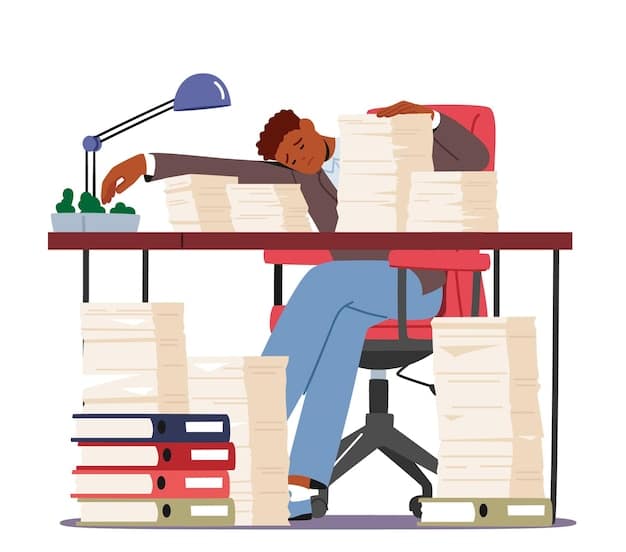Managing Workplace Stress: Strategies for a Healthier Work-Life Balance

Managing workplace stress involves implementing practical strategies and fostering a supportive environment to ensure a healthier work-life balance, benefiting both employees and the organization.
Feeling overwhelmed at work? You’re not alone. Managing workplace stress: practical strategies for a healthier work-life balance can help you regain control and boost your well-being, leading to a more fulfilling and productive career.
Understanding Workplace Stress
Workplace stress is a common issue affecting many individuals globally. It’s essential to understand its sources and effects to implement effective management strategies.
Recognizing the signs and causes of stress is the first step toward creating a healthier work environment and improving overall well-being.
Sources of Workplace Stress
Workplace stress stems from various factors within the work environment. Identifying these sources is crucial for targeted interventions.
- High workload: Excessive tasks and responsibilities can lead to burnout.
- Lack of control: Limited autonomy over tasks increases stress levels.
- Poor relationships: Conflicts with colleagues and supervisors contribute to stress.
- Job insecurity: Uncertainty about job stability heightens anxiety.
These sources can significantly impact an individual’s mental and physical health, highlighting the need for proactive stress management strategies.

Effects of Chronic Workplace Stress
Chronic workplace stress can have detrimental effects on both physical and mental health. Understanding these consequences is vital for prioritizing stress management.
- Physical health issues: Increased risk of cardiovascular diseases and weakened immune system.
- Mental health problems: Elevated anxiety, depression, and burnout.
- Decreased productivity: Reduced efficiency and impaired decision-making abilities.
- Increased absenteeism: Higher rates of sick leaves and reduced job satisfaction.
Addressing workplace stress not only benefits individual well-being but also enhances organizational productivity and success.
In conclusion, understanding the sources and effects of workplace stress is the foundation for developing effective management strategies. By recognizing the underlying issues, organizations and individuals can work together to create a healthier and more productive work environment.
Implementing Effective Time Management
Effective time management is crucial for reducing stress and increasing productivity in the workplace. By prioritizing tasks and optimizing your schedule, you can better handle your workload.
Adopting time management techniques can lead to a more balanced and less stressful workday.
Prioritizing Tasks
Prioritizing tasks involves identifying and focusing on the most important activities. This ensures that critical tasks are completed efficiently.
- Eisenhower Matrix: Categorize tasks based on urgency and importance.
- ABC Analysis: Assign priorities to tasks based on their impact.
- Pareto Principle: Focus on the 20% of tasks that yield 80% of the results.
Using these methods helps in allocating time and energy effectively, reducing overwhelm and increasing productivity.
Time-Blocking Techniques
Time-blocking involves scheduling specific time slots for different activities. This helps in maintaining focus and minimizing distractions.
By using a calendar or planner, you can allocate time for tasks, meetings, and breaks, creating a structured and productive schedule.
Avoiding Procrastination
Procrastination can significantly increase stress levels and reduce productivity. Overcoming procrastination is essential for effective time management.
- Break down tasks: Divide large tasks into smaller, manageable steps.
- Set realistic goals: Avoid overwhelming yourself with unrealistic expectations.
- Reward yourself: Celebrate completing tasks to stay motivated.
Addressing procrastination head-on can lead to improved focus and reduced stress, ultimately boosting productivity and job satisfaction.

In summary, implementing effective time management techniques is essential for reducing workplace stress. Prioritizing tasks, using time-blocking, and avoiding procrastination can significantly improve productivity and overall well-being, leading to a more balanced and fulfilling work life.
Cultivating a Supportive Work Environment
A supportive work environment is crucial for employee well-being and productivity. Fostering open communication and providing resources can significantly reduce workplace stress.
By cultivating a positive and inclusive culture, organizations can enhance employee morale and performance.
Promoting Open Communication
Open communication encourages employees to share their concerns and ideas, fostering a sense of trust and collaboration. Transparency and honesty are key.
Implementing feedback systems, regular team meetings, and open-door policies can promote a more communicative and supportive workplace.
Offering Mental Health Resources
Providing access to mental health resources, such as counseling services and wellness programs, demonstrates a commitment to employee well-being.
- Employee Assistance Programs (EAPs): Confidential counseling and support services.
- Wellness programs: Initiatives focusing on stress reduction, mindfulness, and physical health.
- Mental health workshops: Training sessions to increase awareness and coping skills.
These resources can help employees manage stress, improve their mental health, and enhance their overall quality of life.
Encouraging Work-Life Balance
Promoting work-life balance involves creating policies and practices that support employees’ personal and family needs. Flexibility and understanding are essential.
Offering flexible work arrangements, remote work options, and adequate vacation time can help employees balance their work and personal lives effectively.
By creating a supportive work environment, organizations can reduce workplace stress, improve employee morale, and enhance overall productivity. Open communication, mental health resources, and work-life balance initiatives are key components of a healthy and thriving workplace.
Practicing Mindfulness and Meditation
Mindfulness and meditation are powerful tools for reducing stress and improving mental well-being. Incorporating these practices into your daily routine can have significant benefits.
Developing mindfulness and meditation habits can help you manage stress more effectively.
Benefits of Mindfulness
Mindfulness involves focusing on the present moment without judgment. This practice can help reduce stress, improve focus, and enhance emotional regulation. Benefits include:
- Stress reduction: Lowering cortisol levels and promoting relaxation.
- Improved focus: Enhancing concentration and attention span.
- Emotional regulation: Increasing awareness and control over emotions.
Incorporating mindfulness into your daily routine can lead to enhanced mental clarity and overall well-being. Mindfulness can be practiced anywhere, at any time using a variety of methods.
Simple Meditation Techniques
Meditation involves training the mind to focus and calm thoughts. Simple techniques can be easily integrated into your daily life.
- Breath awareness: Focusing on the sensation of your breath.
- Guided meditation: Following a guided audio or video.
- Body scan: Paying attention to physical sensations in your body.
These techniques can help reduce stress, improve focus, and promote a sense of inner peace.
Integrating Mindfulness into the Workday
Integrating mindfulness into the workday can help manage stress and improve productivity. Taking short breaks to practice mindfulness can make a significant difference.
- Mindful breathing: Taking a few deep breaths before starting a task.
- Walking meditation: Focusing on your steps while walking.
- Gratitude practice: Reflecting on things you are grateful for.
By incorporating mindfulness into your workday, you can reduce stress, improve focus, and enhance your overall well-being.
In conclusion, practicing mindfulness and meditation can significantly reduce workplace stress and improve mental well-being. Integrating these practices into your daily routine can lead to enhanced focus, emotional regulation, and overall quality of life.
Setting Boundaries and Saying No
Setting boundaries and learning to say no are essential for managing workplace stress. Protecting your time and energy can significantly improve your well-being.
Establishing clear boundaries can help prevent burnout and enhance your overall job satisfaction.
Importance of Setting Boundaries
Setting boundaries involves defining limits on your time, energy, and responsibilities. This helps protect your well-being and prevent overcommitment.
Clearly defining your limits can lead to reduced stress, improved focus, and enhanced work-life balance.
Strategies for Saying No
Learning to say no gracefully is crucial for protecting your boundaries. Polite but firm refusal techniques can help manage your workload effectively.
Provide a brief explanation, offer an alternative solution, or suggest another colleague who can assist.
Managing Overcommitment
Overcommitment can lead to increased stress and reduced productivity. Recognizing and managing overcommitment is essential for maintaining a healthy balance.
- Delegate tasks: Assign responsibilities to others when appropriate.
- Prioritize commitments: Focus on the most important tasks and responsibilities.
- Communicate limitations: Clearly express your capacity to manage additional work.
By managing overcommitment effectively, you can reduce stress, improve focus, and enhance your overall well-being.
In summary, setting boundaries and learning to say no are crucial for managing workplace stress. Protecting your time and energy can significantly improve your well-being, prevent burnout, and enhance your overall job satisfaction.
Promoting Physical Well-being
Promoting physical well-being is essential for managing workplace stress. Regular exercise, healthy eating, and adequate sleep are key components of a healthy lifestyle.
Taking care of your physical health can significantly improve your ability to cope with stress and enhance your overall well-being.
Importance of Exercise
Regular exercise has numerous benefits for both physical and mental health. It can reduce stress, improve mood, and increase energy levels. Benefits include:
- Stress reduction: Lowering cortisol levels and promoting relaxation.
- Mood improvement: Releasing endorphins that enhance positive feelings.
- Increased energy: Boosting stamina and reducing fatigue.
Incorporating exercise into your daily routine can significantly improve your ability to manage workplace stress.
Nutrition and Diet
A healthy diet provides the nutrients needed to support both physical and mental health. Avoiding processed foods and sugary drinks can improve energy levels and reduce stress.
Focus on whole foods, lean proteins, and plenty of fruits and vegetables to nourish your body and mind.
Ensuring Adequate Sleep
Adequate sleep is crucial for physical and mental restoration. Lack of sleep can increase stress, reduce focus, and impair decision-making abilities.
Aim for 7-9 hours of quality sleep per night to support optimal health and well-being.
In conclusion, promoting physical well-being is essential for managing workplace stress. Regular exercise, a healthy diet, and adequate sleep can significantly improve your ability to cope with stress and enhance your overall well-being.
| Key Point | Brief Description |
|---|---|
| ⏰ Time Management | Prioritize tasks, use time-blocking, and avoid procrastination. |
| 🤝 Supportive Environment | Promote open communication and offer mental health resources. |
| 🧘 Mindfulness & Meditation | Reduce stress with breath awareness and guided meditation. |
| 💪 Physical Well-being | Exercise regularly, eat healthy, and ensure adequate sleep. |
Frequently Asked Questions
▼
Common causes include high workload, lack of control, poor relationships with colleagues, and job insecurity. Addressing these issues can significantly reduce employee stress.
▼
Prioritize tasks using methods like the Eisenhower Matrix, use time-blocking techniques, and avoid procrastination by breaking tasks into smaller steps.
▼
Offer Employee Assistance Programs (EAPs) for confidential counseling, wellness programs focusing on stress reduction, and mental health workshops to increase awareness.
▼
Mindfulness reduces stress by lowering cortisol levels, improving focus by enhancing concentration, and increasing emotional regulation by promoting awareness and control.
▼
Setting boundaries protects your time and energy, reducing stress and preventing overcommitment. It leads to improved focus, enhanced work-life balance, and overall well-being.
Conclusion
Managing workplace stress: practical strategies for a healthier work-life balance is crucial for both employee well-being and organizational success. By implementing effective time management techniques, fostering a supportive work environment, practicing mindfulness, setting boundaries, and promoting physical well-being, individuals and organizations can create a healthier, more productive, and fulfilling work life.





